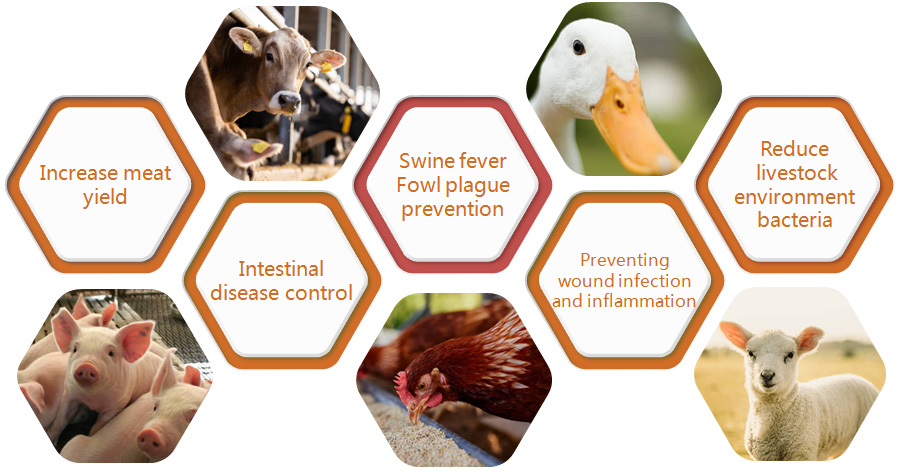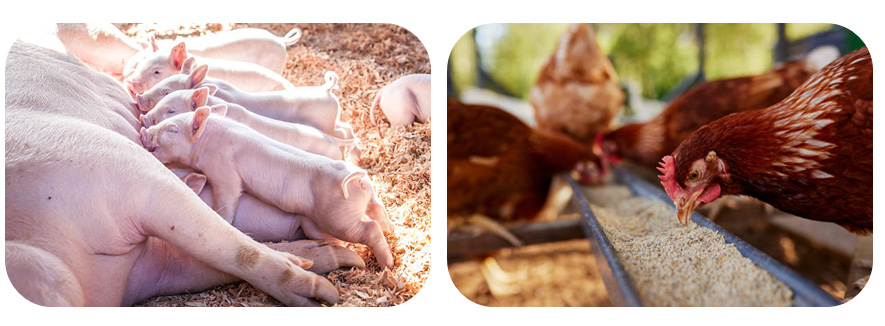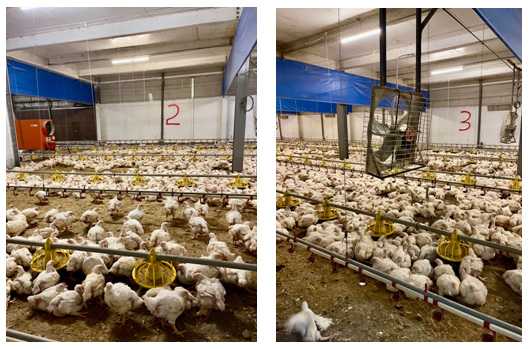Water Soluble nZnO - Livestock

Chicken/Duck/Goose
Disease prevention and health improvement
66.67g /ton of water or feed (10ppm)
Pig/Lamb/Cattle
Disease prevention and health improvement
100g/ton of water or feed (15ppm)
Advanced health care
400g/ton of water or feed (60ppm)
|
Animal |
General epidemic disease |
|
Piglet |
Porcine epidemic diarrheavirus,PEDv |
|
Chicken |
Avianinfluenza,AI Infectiousbronchitis,IB InfectiousLaryngotracheitis,ILT Egg dropsyndrome,EDS Marek'sdisease,MD Newcastledisease,ND |
|
Duck |
Duck plague New Duck Disease |
|
Goose |
Goslings viral enteritis Infectious serositis Paratyphoid infection Staphylocosis |
|
Lamb |
Peste des petits ruminants |
|
Cattle |
bovineephmeralfever, BEF |

Water Soluble nZnO - Dealing PEDv
|
Test 1 |
|
|
Testing organization |
Taiwan Livestock Corporation |
|
Virus |
PEDv |
|
Material |
HYZnON-15 45ppm |
|
Experimental animals |
Poisoning piglets during lactation (weight 3-5 kg) |
|
Number of piglet |
5 |
|
Testing process |
Weaned piglets had diarrhea and were treated with antibiotics for more than ten days, but the treatment was ineffective; AddHYZnON-15 to drinking water until diarrhea symptoms stop |
|
Testin time |
2022/SEP/5th~SEP/8th |
|
5 suckling piglets developed diarrhea and were confirmed to be infected withPEDv. The diarrhea stopped after 3 days, and the improvement success rate was 100% |
|
Water Soluble nZnO - Save more piglets
|
Test 2 |
|
|
Testing organization |
Taiwan Nantou County pig farm |
|
Material |
HYZnON-15 |
|
Test design |
Experimental group - sow feed & piglet feed, supplemented withHYZnON-15 Blank group - sow feed & piglet feed, withoutHYZnON-15 Tested in two zones simultaneously |
|
Test process |
15ppm (1:10000) through feed Sows: Eat a sow feed containingHYZnON-15 for 6 weeks Piglets: Consume feed containingHYZnON-15 for 4 weeks |
|
Conclusion |
The experimental group withHYZnON-15 had a higher number of live piglets. The experimental groups measured +0.6% and +2.1% improvement in piglet survival rate |
Water Soluble nZnO - Chicken farm
|
Location |
Taiwan chicken farm |
|
Number of chickens |
38,000 each farm |
|
Test date |
2023/DEC. to 2024/MAR |
|
Concentration |
10ppmHYZnON-15 (1:15000) |
|
Test method |
HYZnON-15 taken in by drinking water throughout the day, and the chickens were treated for 3 consecutive weeks. |
|
Note : No other antibiotic or drugs used. It is also recommended to sprayHYZnON-15 through an atomizer to directly reduce the virus content, and administer it to the lungs through free breathing to improve the immunity of the chickens. |
|

|
Farm feeding results (Experimental group) with HYZnON-15 |
Farm feeding results (Blank group) |
||||||
|
Date of entry: 2024.01.31 |
Chicken release date: 2024.03.04 |
Date of entry: 2023.12.01 |
Chicken release date: 2024.01.02 |
||||
|
Number of fledglings: |
38,000 |
Foot-pad contact dermatitis |
18 |
Number of fledglings: |
38,000 |
Foot-pad contact dermatitis |
3 |
|
Number of adult chickens caught: |
37,840 |
Dermatitis(%) |
0 |
Number of adult chickens caught: |
37,670 |
Dermatitis(%) |
5 |
|
Breeding rate (%): |
99.58% |
Number of dead chickens on the truck |
96 |
Breeding rate (%): |
99.13% |
Number of dead chickens on the truck |
184 |
|
Average feed intake per feather (KG): |
3.21 |
Number of chickens removed before slaughter |
73 |
Average feed intake per feather (KG): |
2.94 |
Number of chickens removed before slaughter |
110 |
|
Average weight (KG): |
2.29 |
|
|
Average weight (KG): |
2.08 |
|
|
|
Production Index: |
480.6 |
|
|
Production Index: |
440.4 |
|
|
The number of deaths before slaughter also decreased significantly.
It is speculated that it has a stabilizing effect after consumption.
The production index increased by 9.13% (from 440.4 to 480.6)
